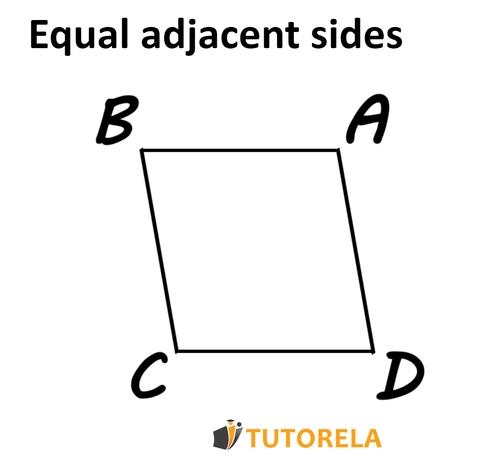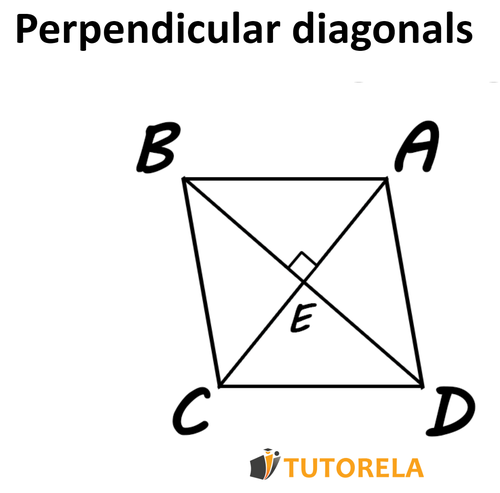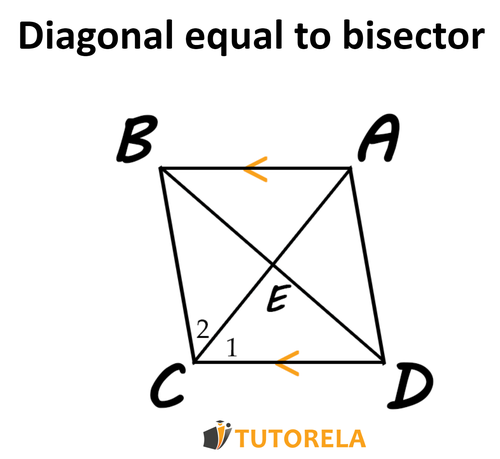You will be able to determine that the parallelogram is a rhombus if at least one of the following conditions is met:
From Parallelogram to Rhombus
Test yourself on from a parallelogram to a rhombus!
Look at the parallelogram below:
If the diagonals cross at 90 degree angles at the center of the parallelogram.
Is this parallelogram considered a rhombus?
From Parallelogram to Rhombus
How will you realize that the parallelogram in front of you is a rhombus?
We are here to teach you 3 criteria by which you can demonstrate, quickly and simply, that you have a rhombus in front of you.
First let's remember the definition of a rhombus.
The definition of a rhombus says the following: it is a parallelogram that has a pair of sides (or edges) adjacent that are equal.
First criterion - Adjacent sides equal
If the parallelogram has a pair of equal adjacent sides, it is a rhombus.
You can use this theorem to show that it is a rhombus without having to prove it.
However, for you to understand the logic behind it, we will demonstrate this theorem below.
Data:
Parallelogram

We have to prove that: is a rhombus
Solution:
Since we have that is a parallelogram, we deduce that:
because, in the parallelogram, each pair of opposite sides are also equivalent.
Let's observe our data
Now, we can determine that all sides of the parallelogram are equivalent according to the transitive relation.
We obtain:
Indeed, is a quadrilateral with all its sides equal, therefore, it is a rhombus.
Can the given parallelogram be considered a rhombus?
Can the above parallelogram be considered a rhombus?
Given the parallelogram:
Is this parallelogram a rhombus?
Second criterion - Perpendicular diagonals
If in the parallelogram the diagonals bisect each other forming angles of degrees, that is, they are perpendicular, it is a rhombus.
You can use this theorem to show that it is a rhombus without having to prove it.
However, for you to understand the logic behind it, we will demonstrate this theorem below.
Data:
Parallelogram

It must be demonstrated that: is a rhombus
Solution:
Based on the first criterion, we already know that, it is enough for us to see that in the parallelogram there are two adjacent equivalent sides for us to know that it is a rhombus.
We can see that there is in this parallelogram a pair of adjacent equivalent sides if we use the congruence of triangles and .
We will place them on top of each other:
Side common side, of the same length.
Angle These angles measure 90º since we know that the diagonals that create them are perpendicular.
Side in the parallelogram, the diagonals intersect
From this it follows that: according to SAS
And, consequently,
we will be able to determine that:
According to the congruence, corresponding sides are equivalent.
We will notice that and are adjacent equivalent sides in the parallelogram and, therefore, we will be able to determine that is a rhombus since a parallelogram with a pair of adjacent equivalent sides is a rhombus.
Third Criterion - Diagonal equal to bisector
If in the parallelogram one of the diagonals is the bisector - it is a rhombus.
You can use this theorem to show that it is a rhombus without having to prove it.
However, for you to understand the logic behind it, we will prove this theorem below.
Data:
Parallelogram

We have to prove that: is a rhombus
Solution:
Let's remember, a parallelogram that has a pair of equal adjacent sides is a rhombus.
Let's start:
From the data we have we can deduce since in a parallelogram, the opposite sides are also parallel.
Then: , alternate angles between parallel lines are equivalent.
According to the transitive relation, .
Now we can deduce that:
In the triangle, opposite equivalent angles there are sides equal to each other.
Now we can determine that is a rhombus.
We found in the parallelogram a pair of equal adjacent sides, therefore, it is a rhombus.
Suggestion:
To remember the three theorems that prove that a parallelogram is a rhombus, try to remember the three key terms: sides, diagonals, and angles.
Great!
Now you know all the criteria to prove that a parallelogram is a rhombus.
Examples and exercises with solutions from parallelogram to rhombus
Exercise #1
Look at the parallelogram below:
If the diagonals cross at 90 degree angles at the center of the parallelogram.
Is this parallelogram considered a rhombus?
Video Solution
Step-by-Step Solution
The parallelogram whose diagonals are perpendicular to each other (meaning the angle between them is ) is a rhombus, therefore the given parallelogram is a rhombus.
Therefore, the correct answer is answer A.
Answer
Yes.
Exercise #2
Can the given parallelogram be considered a rhombus?
Video Solution
Step-by-Step Solution
The definition of a rhombus is "a parallelogram with equal sides"
In the parallelogram shown in the drawing, the adjacent sides are clearly not equal in length,
Therefore the parallelogram shown in the drawing cannot be considered a rhombus.
Therefore the correct answer is answer B.
Answer
No
Exercise #3
Can the above parallelogram be considered a rhombus?
Video Solution
Step-by-Step Solution
The definition of a rhombus is "a quadrilateral with all equal sides"
Therefore, the square in the diagram is indeed a rhombus
Thus, the correct answer is answer A.
Answer
True
Exercise #4
Given the parallelogram:
Is this parallelogram a rhombus?
Video Solution
Answer
Not true
Exercise #5
Given the parallelogram:
Is this parallelogram a rhombus?
Video Solution
Answer
True
Given the parallelogram:
Is this parallelogram a rhombus?
Look at the parallelogram below:
The diagonals form 2 pairs of different angles at the center of the parallelogram.
Is the parallelogram a rhombus?
Is this parallelogram necessarily a rhombus?
- Area
- Trapezoids
- Symmetry in Trapezoids
- Diagonals of an isosceles trapezoid
- Types of Trapezoids
- Isosceles Trapezoid
- Parallelogram
- Identifying a Parallelogram
- Rotational Symmetry in Parallelograms
- From the Quadrilateral to the Parallelogram
- Kite
- Rectangle
- From a Quadrilateral to a Rectangle
- From a Parallelogram to a Rectangle
- Square
- Area of a square
- From Parallelogram to Square
- Rhombus, kite, or diamond?
- Diagonals of a Rhombus
- Lines of Symmetry in a Rhombus
- The Area of a Rhombus
- How do we calculate the area of complex shapes?
- Diagonals in a rectangle
- Symmetry in a kite









